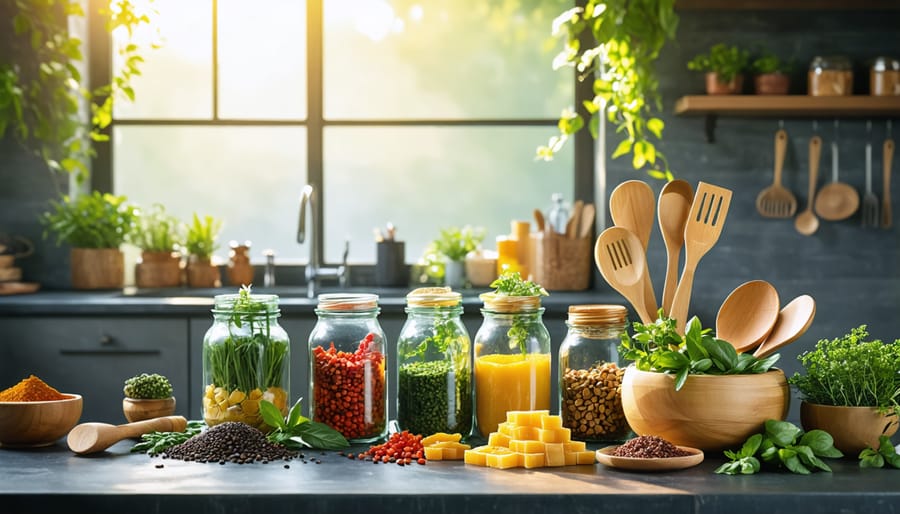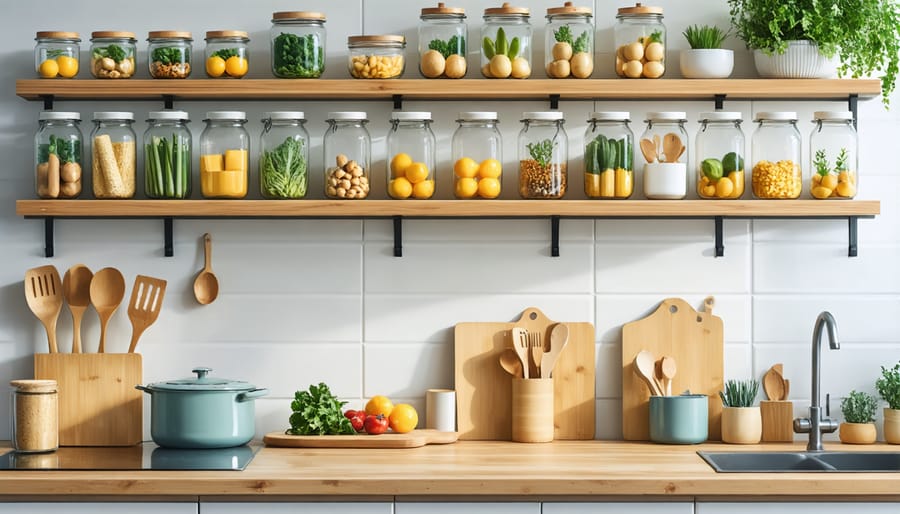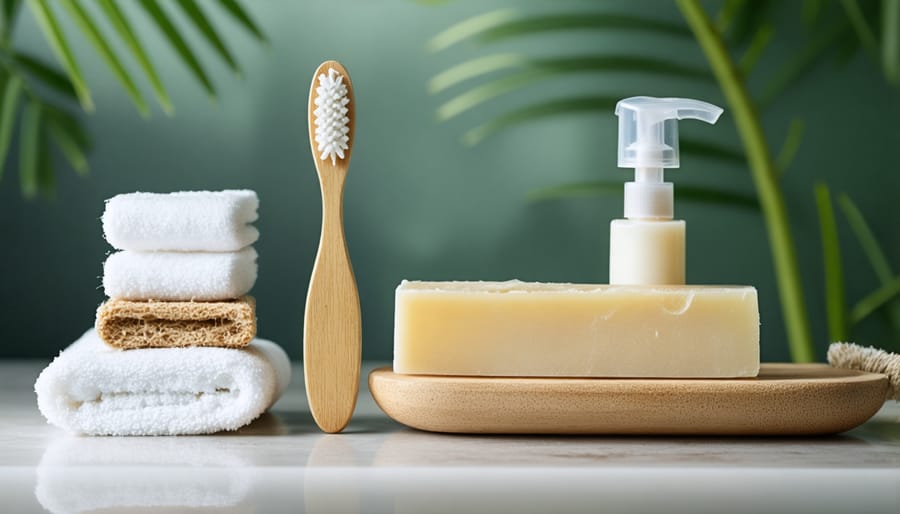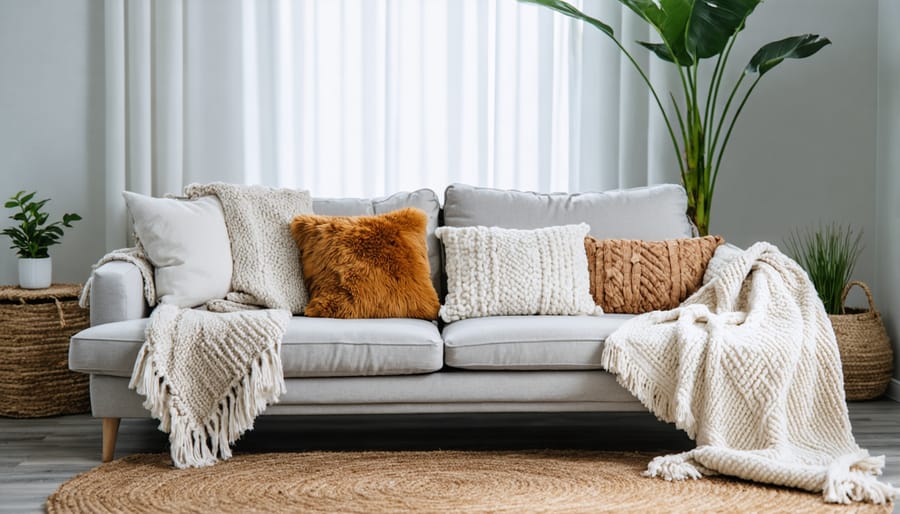
Transform your home into an eco-conscious sanctuary by replacing single-use plastics with bamboo alternatives, swapping chemical cleaners for vinegar-based solutions, and choosing energy-efficient LED bulbs throughout your living spaces. Creating sustainable eco-friendly habits doesn’t require a complete lifestyle overhaul – small, intentional changes in our daily routines can significantly reduce our environmental impact while creating a healthier living space.
Like many of you, I started my sustainability journey in the kitchen, replacing plastic wrap with beeswax covers and disposable sponges with washable, organic cotton alternatives. The beauty of eco-friendly home essentials lies in their dual purpose: they not only protect our planet but often prove more cost-effective and durable than their conventional counterparts. From biodegradable dish brushes to reusable produce bags, these mindful swaps create a ripple effect that extends far beyond our homes, inspiring friends and family to embrace more sustainable choices in their own lives.
Kitchen Essentials That Mother Earth Would Love
Sustainable Food Storage Solutions
Let me share a game-changing moment in my sustainable journey: the day I finally bid farewell to single-use plastic wrap and disposable storage bags. Trust me, making the switch to eco-friendly food storage solutions is easier than you might think, and your kitchen will thank you for it!
Reusable glass containers are my absolute go-to for storing everything from leftover curry to pre-prepped veggies. They’re incredibly versatile, dishwasher-safe, and won’t absorb food odors like plastic containers do. I especially love how they stack neatly in the fridge, making organization a breeze.
Beeswax wraps have become another kitchen staple, and they’re a beautiful alternative to plastic wrap. These cotton cloths coated with beeswax, jojoba oil, and tree resin conform to any shape with just the warmth of your hands. They’re perfect for covering bowls, wrapping cheese, or packaging sandwiches for lunch.
For bulk pantry items, mason jars and other glass containers with airtight seals keep dry goods fresh while looking aesthetically pleasing on your shelves. Pro tip: opt for wide-mouth jars for easier scooping! And for those who love farmers’ market shopping, lightweight mesh produce bags are fantastic for storing fruits and vegetables.
Remember to label your containers with washable markers or cute chalkboard labels – it helps keep track of what’s inside and when items were stored. These sustainable swaps not only reduce waste but also bring a thoughtful, organized charm to your kitchen space.

Green Cleaning Champions
Making your kitchen sparkle doesn’t have to come at the cost of your health or the environment. I remember when I first switched to natural cleaning methods, I was amazed at how effective simple ingredients could be. Let’s explore some eco-friendly cleaning champions that’ll keep your kitchen naturally pristine!
White vinegar and baking soda are your dynamic duo for tackling everything from greasy stovetops to stubborn sink stains. I keep a spray bottle filled with a 1:1 vinegar-water solution for daily wipe-downs. For tougher jobs, sprinkle baking soda first, then spray with the vinegar solution – watch the cleaning magic happen!
Trade those disposable paper towels for reusable cleaning cloths made from organic cotton or bamboo. My favorite hack is keeping a collection of old cotton t-shirts cut into cleaning squares. They’re perfect for everything from wiping counters to drying dishes.
For dishes, opt for biodegradable dish soap and natural scrubbers like coconut coir brushes or loofah sponges. These sustainable alternatives work just as effectively as their plastic counterparts while being gentler on our planet.
Essential oils like tea tree, lemon, and lavender add natural antimicrobial properties to your cleaning routine while making your kitchen smell divine. Just a few drops in your vinegar solution creates a powerful, fresh-scenting cleaner that’s completely natural.
Bathroom Basics That Care for You and the Planet

Zero-Waste Personal Care
When I first started my journey toward sustainable home decor and living, personal care products were my biggest challenge. Now, I’m excited to share some game-changing alternatives that have transformed my bathroom routine. Start with a bamboo toothbrush and natural tooth tablets that come in refillable glass jars – they work just as well as traditional options without the plastic waste.
Replace disposable razors with a sleek safety razor; while the initial investment is higher, the metal blades are incredibly affordable and completely recyclable. For haircare, solid shampoo and conditioner bars are revelatory – they last longer than bottled products and travel beautifully. I’ve fallen in love with package-free soap bars and natural deodorant in cardboard tubes.
Consider switching to a menstrual cup or period underwear instead of disposable products. These alternatives not only reduce waste but often save money in the long run. For skincare, look for products in glass containers or try multi-purpose items like coconut oil, which works as a makeup remover and moisturizer. Remember, transitioning to zero-waste personal care doesn’t have to happen overnight – start with one swap at a time and build from there.
Water-Wise Solutions
Let’s talk about one of my favorite eco-friendly home transformations – the bathroom! I used to worry about our family’s water consumption until I discovered some amazing water-saving solutions that make a real difference without compromising comfort.
Start with a low-flow showerhead – it’s such a simple switch but can reduce water usage by up to 50%! I installed one last year, and honestly, the pressure feels just as good as our old water-guzzling model. For an extra boost in efficiency, consider a shower timer. I keep a cute little hourglass timer in my bathroom, making it a fun challenge to finish before the sand runs out.
Dual-flush toilets are another game-changer. If you’re not ready to replace your toilet, try a water displacement device in your tank – even a filled water bottle works! And don’t forget about those sneaky leaks; a single dripping faucet can waste thousands of gallons yearly.
My personal favorite is the faucet aerator – it’s budget-friendly and takes minutes to install. By mixing air with water, it maintains pressure while reducing flow. I’ve added these to every sink in our home, and guests never notice the difference except when they compliment our lower water bills!
Living Room and Bedroom Sustainability
Sustainable Textiles and Decor
When I transformed my home’s textiles and decor to eco-friendly alternatives, I was amazed by how these simple changes made such a big impact. Let’s explore some beautiful, sustainable options that don’t compromise on style.
Natural fabrics are your best friends when it comes to sustainable textiles. Organic cotton, hemp, and linen are excellent choices for everything from curtains to throw pillows. These materials not only look gorgeous but are also biodegradable and produced with significantly less environmental impact than conventional options.
For bedding and throws, consider bamboo fabrics or TENCEL™ – they’re incredibly soft, naturally moisture-wicking, and produced using closed-loop systems that minimize waste. I’ve found that these materials actually get softer with each wash, making them a joy to use daily.
When it comes to decorative elements, look for items made from recycled materials or sustainable sources. Think reclaimed wood picture frames, cork decorative pieces, or macramé wall hangings made from organic cotton. Plants are also wonderful decor elements that naturally purify your air while adding life to your space.
Consider secondhand or vintage pieces too – they often have unique character and prevent new resource consumption. I found some of my favorite decorative pieces at local thrift stores, including brass candlesticks and handwoven baskets that add warmth and personality to my rooms while supporting circular consumption.
Remember, transitioning to sustainable decor doesn’t mean replacing everything at once. Start with items that need replacing anyway, and gradually build your collection of eco-friendly pieces that reflect your personal style.

Energy-Efficient Solutions
Let me share a game-changing discovery from my own eco-journey: switching to smart power strips cut my electricity bill by 15% in just one month! It’s amazing how these small changes can make such a big difference in both our environmental impact and our wallets.
Today’s energy-efficient solutions combine the best of technology and mindful living. Start with LED bulbs – they use 75% less energy than traditional ones and last up to 25 times longer. Smart thermostats like Nest or Ecobee learn your schedule and automatically adjust temperatures, potentially saving 10-12% on heating and 15% on cooling costs.
One of my favorite additions has been motion sensor lights in less-frequented areas like the basement and garage. They ensure lights aren’t left on unnecessarily, which my kids were notorious for doing! Window treatments also play a crucial role – cellular shades can reduce heat loss through windows by 40% in winter and block unwanted heat gain in summer.
Consider upgrading to ENERGY STAR certified appliances when replacing old ones. While they might cost more upfront, they typically use 10-50% less energy than standard models. For immediate impact, try using cold water for laundry and running dishwashers only when full.
Remember, energy efficiency isn’t just about gadgets – it’s about creating mindful habits that become second nature. Start with one or two changes and build from there. Your future self (and the planet) will thank you!
Transforming your home into an eco-friendly haven doesn’t have to be overwhelming or happen overnight. As we’ve explored throughout this article, there are countless ways to make sustainable choices that benefit both our planet and our daily lives. By incorporating these eco-friendly essentials, you’re not just creating a healthier living space for yourself and your family – you’re also contributing to a more sustainable future for generations to come.
I remember when I first started my sustainable journey, switching to reusable grocery bags seemed like such a small step. But those small changes quickly added up, leading to bigger transformations in how I approach household choices. Whether you’re starting with plastic-free kitchen alternatives, switching to natural cleaning products, or investing in energy-efficient appliances, every eco-conscious decision makes a difference.
The best part? Many of these sustainable swaps actually save money in the long run while reducing waste and your carbon footprint. Plus, there’s something incredibly satisfying about knowing your home reflects your values and commitment to environmental stewardship.
Ready to begin your eco-friendly home transformation? Start small, celebrate your progress, and remember that perfection isn’t the goal – progress is. Choose one area of your home to focus on first, and gradually expand your sustainable practices as you feel comfortable. Your journey to a more eco-conscious lifestyle is unique to you, and every step forward counts toward a greener, cleaner planet for all of us.



